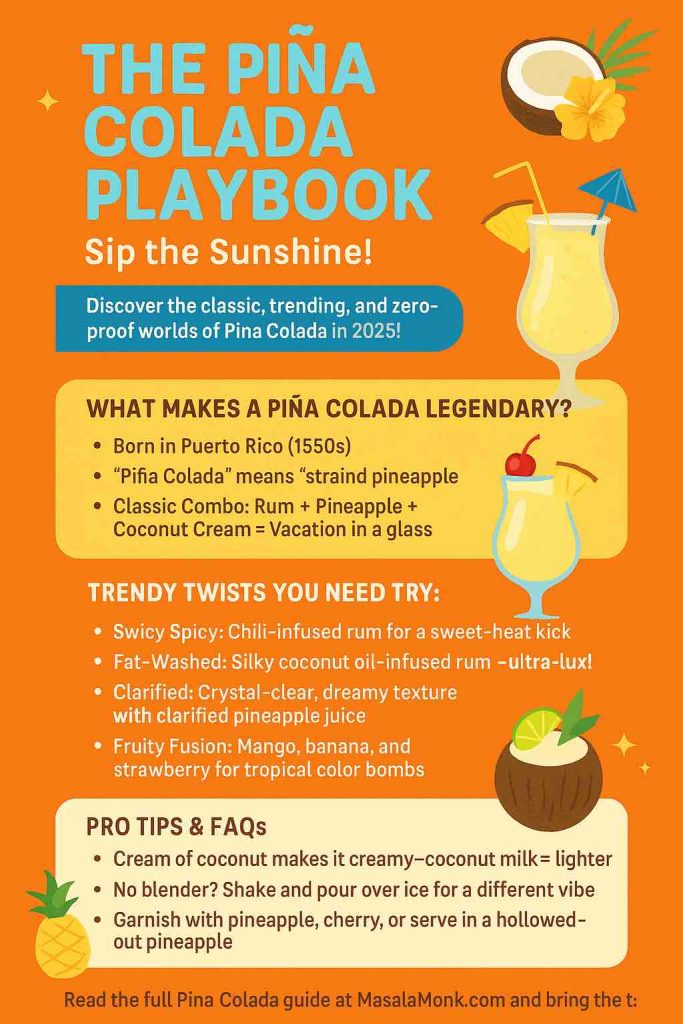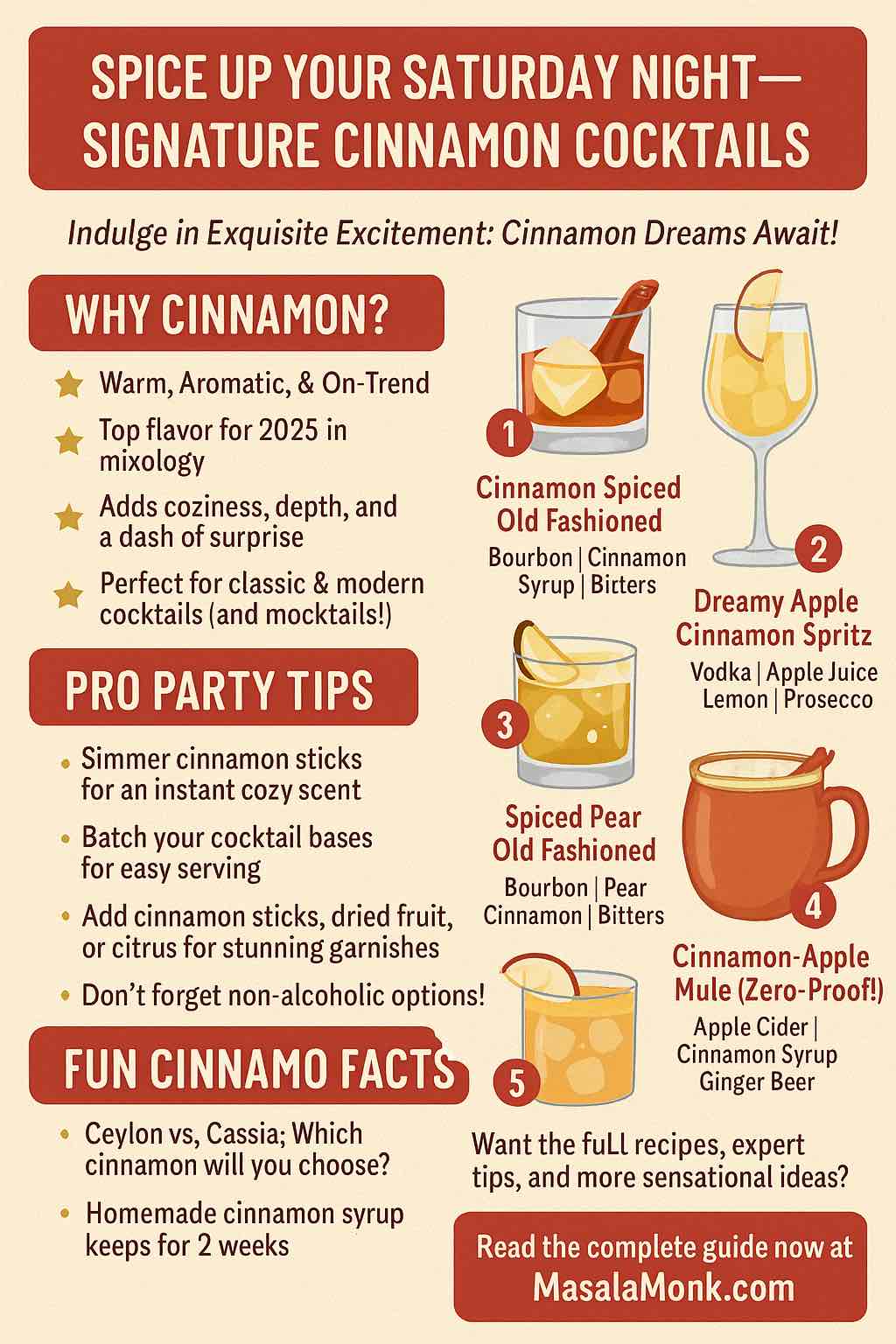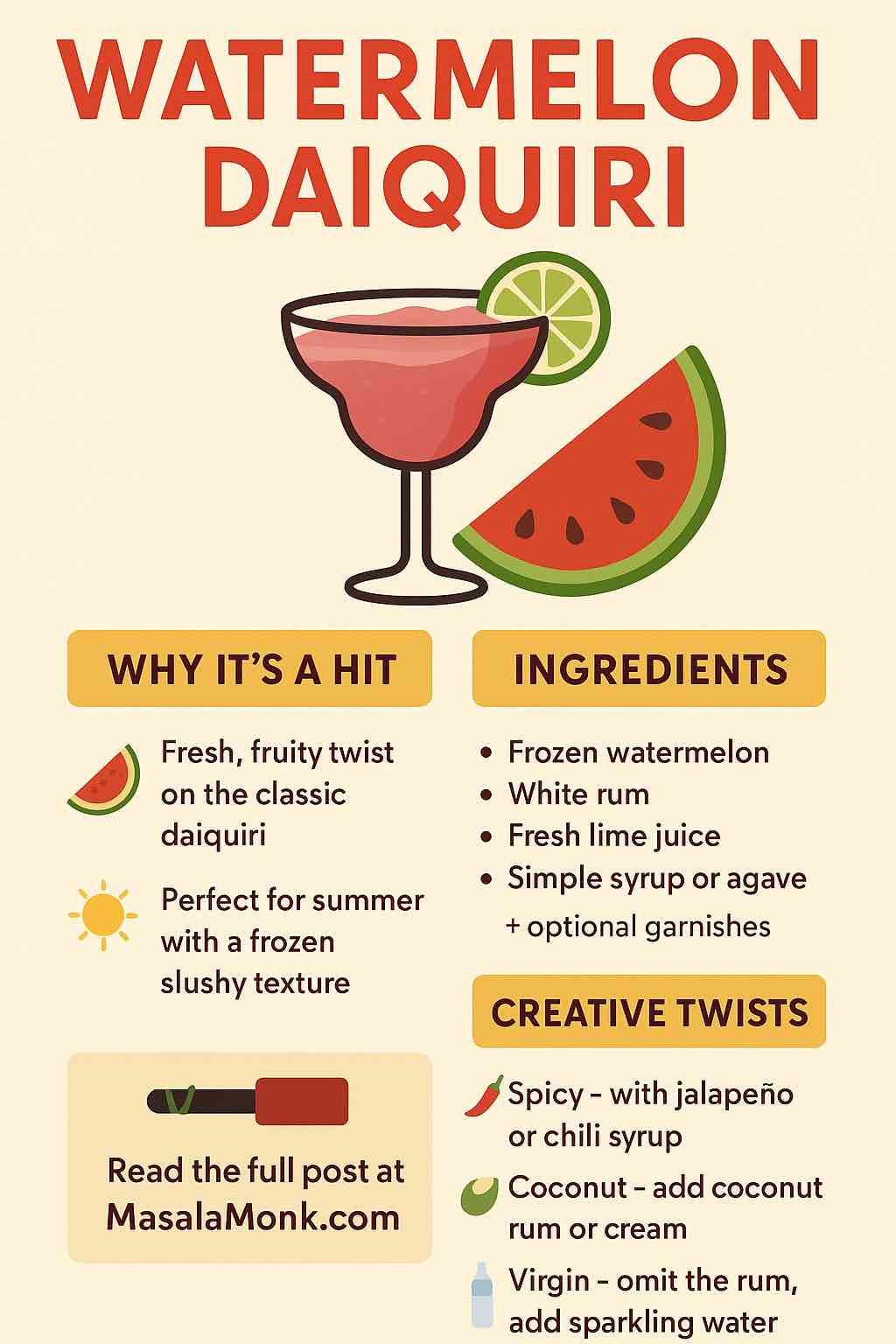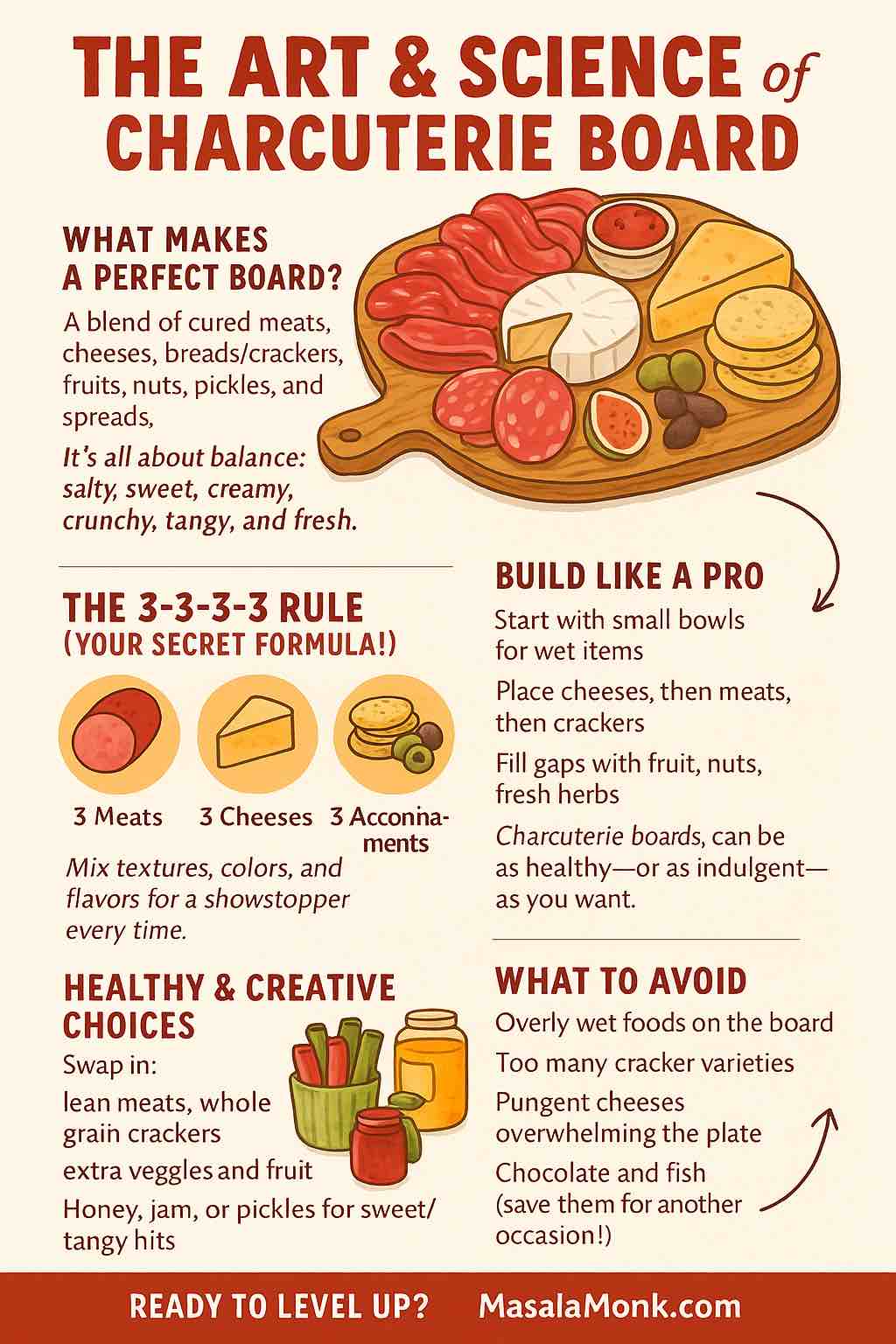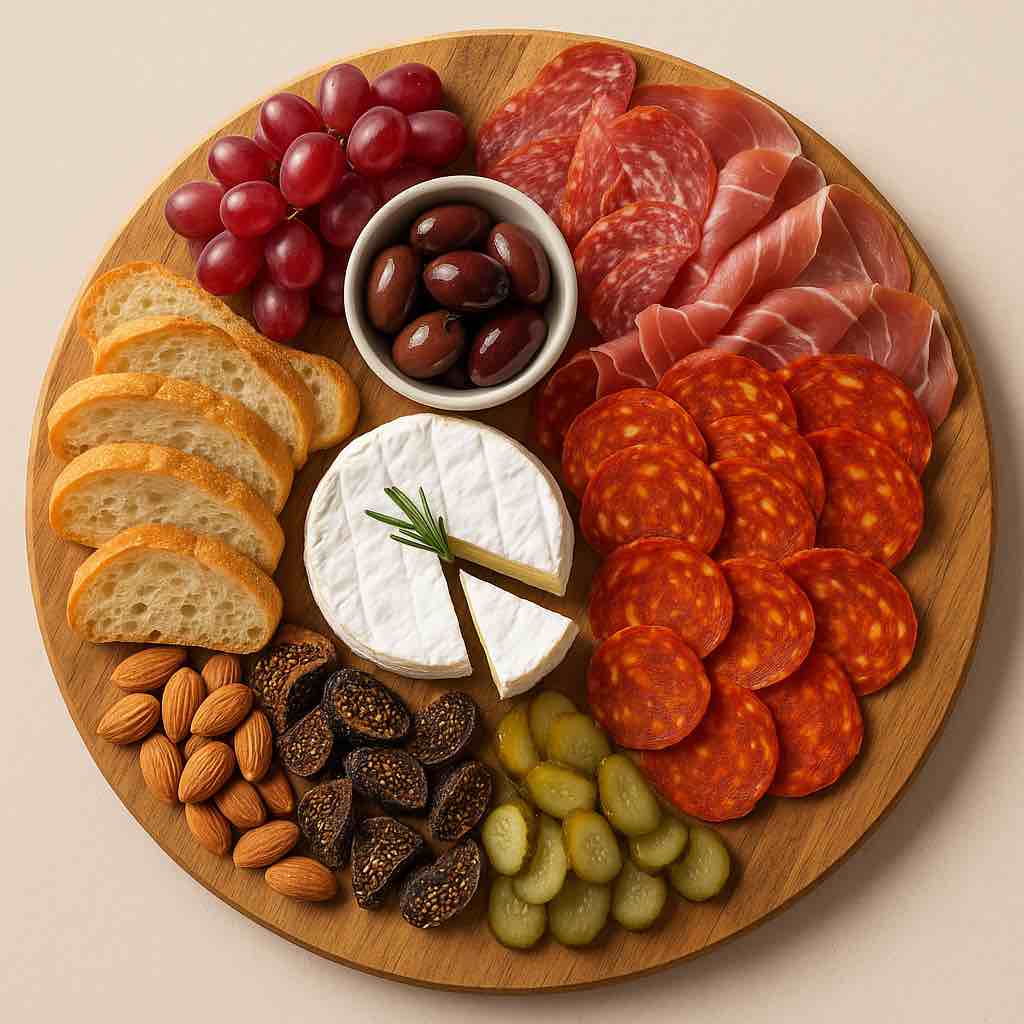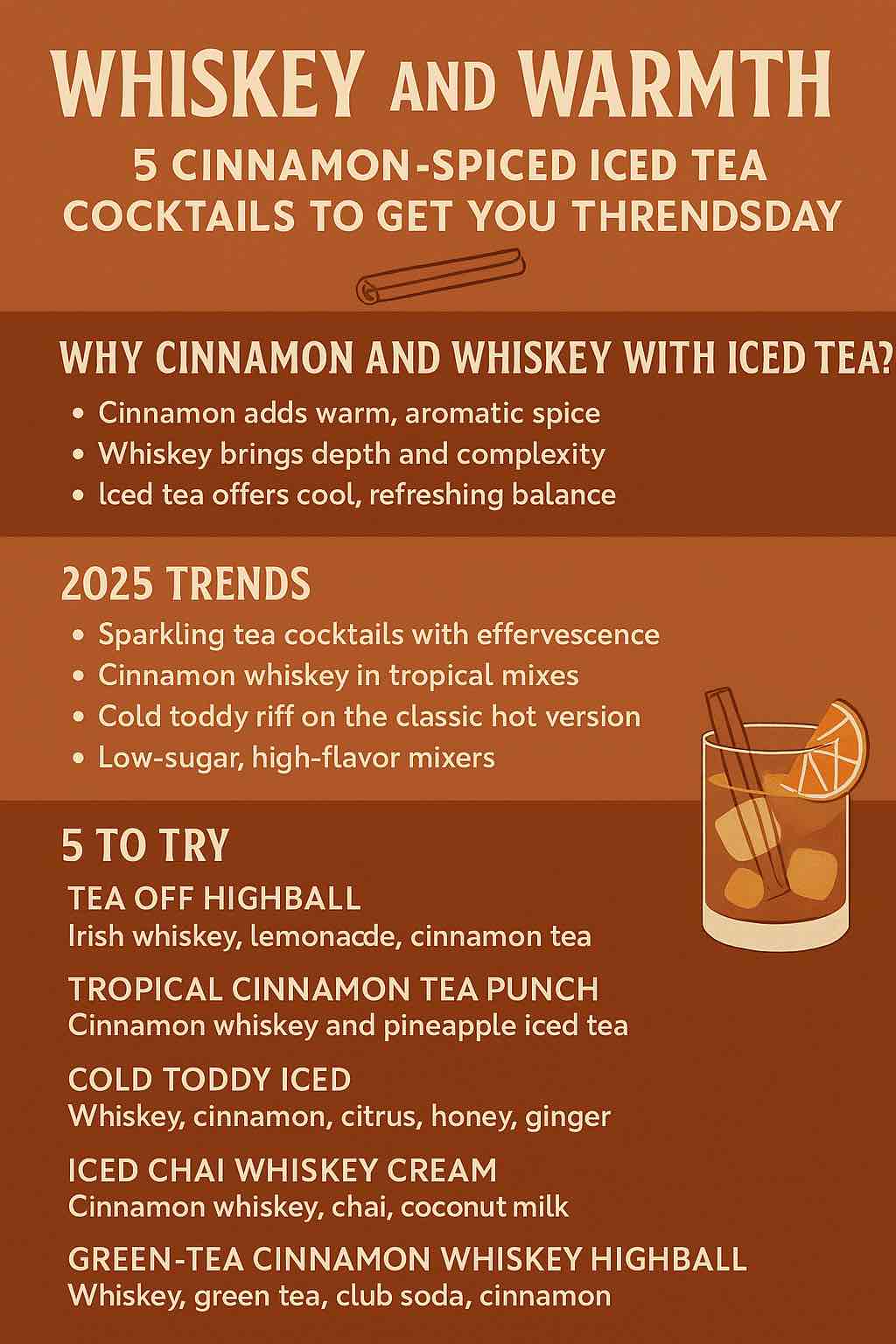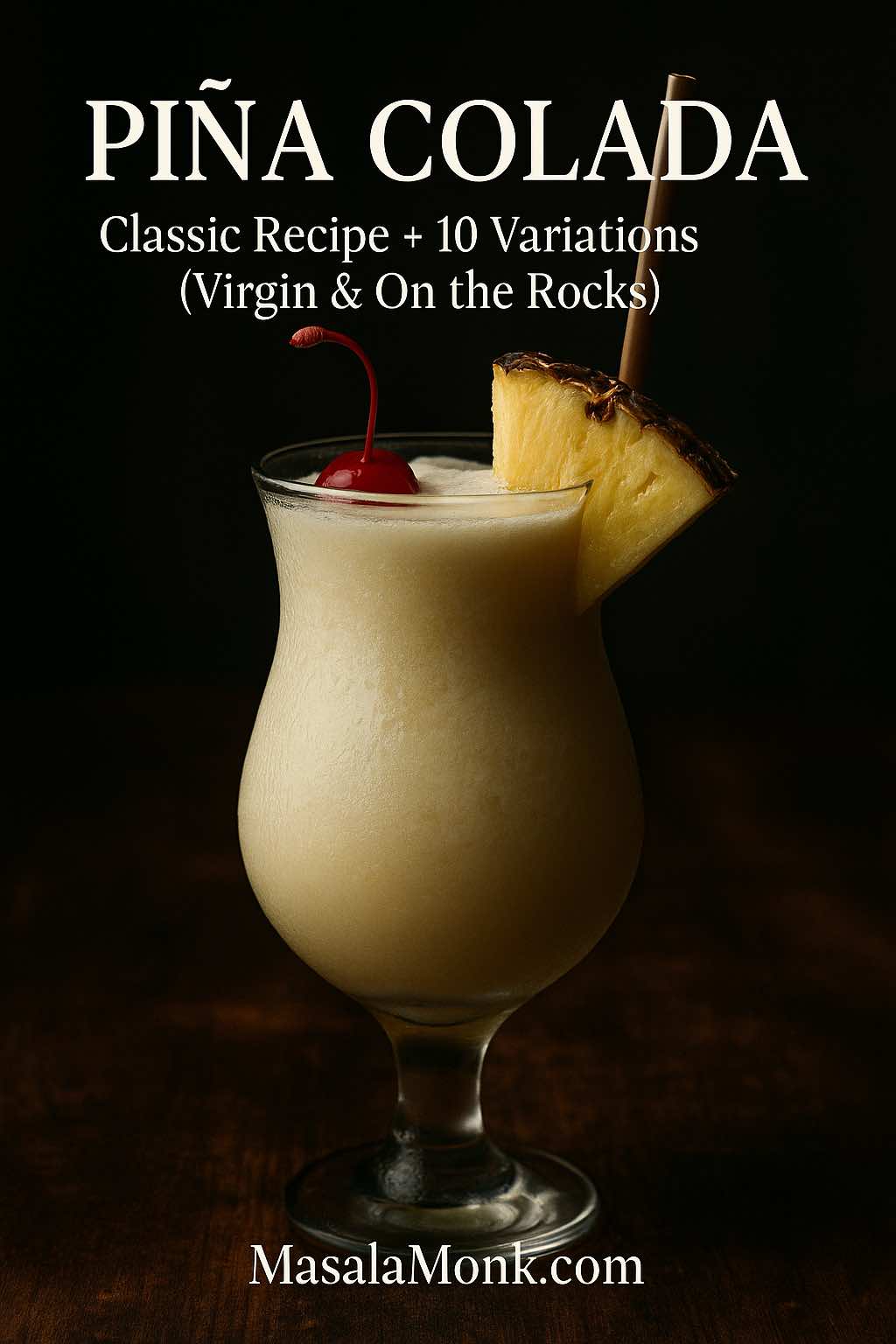
Some drinks whisper “holiday,” yet the piña colada practically sings it. If you love that beach-in-a-glass feeling, you’re in the right place. First, we’ll lock in the frozen classic that tastes like sunshine. Next, we’ll switch to an easy piña colada on the rocks for no-blender nights. Then, because it’s fun to play, we’ll explore practical pina colada variations you can master in minutes—strawberry, mango, blue curaçao, coconut-rum, spiced-rum, vodka, tequila, skinny, keto-leaning, and frozen pineapple. Finally, since not every occasion calls for alcohol, we’ll craft a zero-proof version that’s indulgent without spirits.
Before we blend, a tiny language detour helps. In Spanish, piña colada literally means “strained pineapple,” a nod to the pressed juice at the drink’s core — see Etymonline’s word history and the concise entry at Merriam-Webster. Meanwhile, let’s keep the focus on flavor and technique.
What does piña colada mean?
Piña colada means “strained pineapple.” Traditionally, it pairs pineapple with coconut and rum; however, you can easily make a virgin piña colada by skipping the rum and balancing sweetness with a little lime or a splash of coconut water.
Because stories matter almost as much as flavor, here’s the short origin postcard. Puerto Rico celebrates the piña colada as its national cocktail, and San Juan still debates where it was first poured. Many point to Ramón “Monchito” Marrero at the Caribe Hilton in the 1950s, while others mention competing claims across town. For a friendly primer, read Discover Puerto Rico’s guide, and for the hotel’s version of events, browse the Caribe Hilton history page.
Frozen vs. On the Rocks: choose your texture before you start
First, decide your vibe. Frozen is creamy, slushy, and a touch dessert-leaning—perfect for lingering afternoons or sunny patios. On the rocks, by contrast, is shaken hard with ice and served over fresh cubes; it’s quicker, brighter, and lets rum aromas peek through. As a result, many people pick frozen for weekends and rocks for weeknights.
If you often serve a crowd, prep a thick frozen base and, meanwhile, keep extra pineapple juice chilled. Then, when someone wants a lighter drink, shake a single serving with a splash of juice and strain it over ice for an instant piña colada on the rocks. If you prefer a visual of the shaken style, this walkthrough for a Piña Colada on the Rocks (Shaken) mirrors the method below.
Classic Piña Colada (Frozen)
Why it works. Pineapple brings tang and perfume; cream of coconut adds velvety body and gentle sweetness; white rum lifts aromatics so the finish feels sunny rather than heavy. For proportions, the classic split of rum + pineapple + cream of coconut gives a balanced canvas; from there, adjust to your blender and your preferred sweetness.
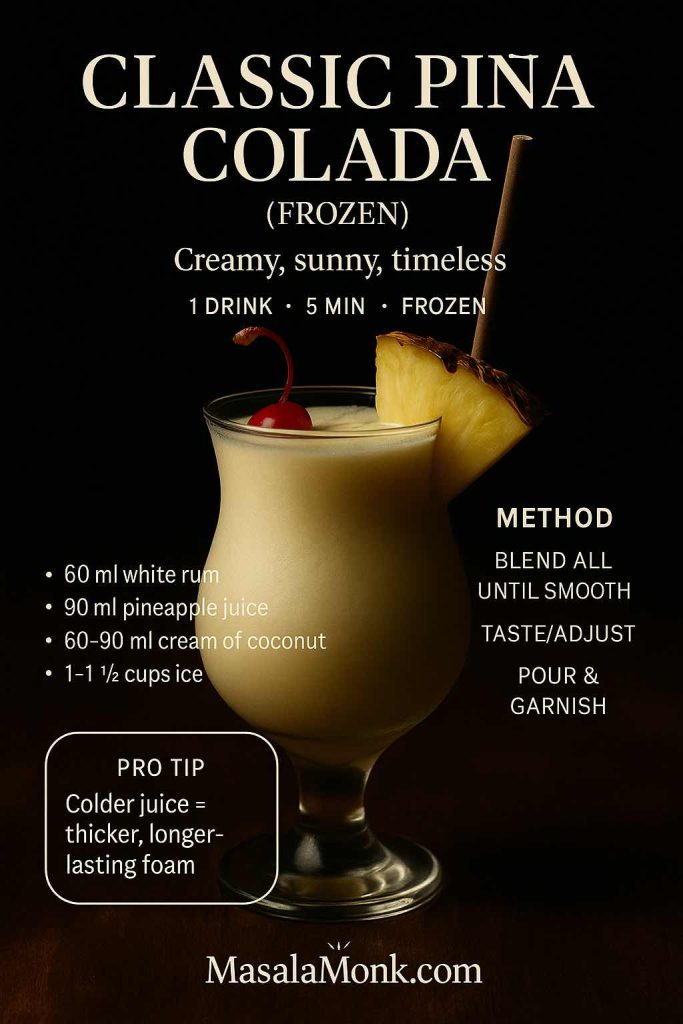
Ingredients (1 drink)
- 60 ml white rum (¼ cup)
- 90 ml pineapple juice (⅜ cup)
- 60–90 ml cream of coconut (¼–⅜ cup), to taste
- 1–1½ cups ice
- Pineapple wedge and cherry, to garnish
Method
- Chill a tall glass; meanwhile, add rum, pineapple juice, and cream of coconut to the blender.
- Add ice and blend until smooth and pourable. If the blades stall, loosen with a small splash of juice.
- Taste and adjust—if it’s too thick, a little more juice helps; if sweetness lingers, a few drops of lime tidy the finish.
- Pour, garnish, and serve immediately for maximum frostiness.
Coconut note. Cream of coconut isn’t the same as coconut milk or unsweetened coconut cream. Because cream of coconut is sweetened and thicker, it creates that signature silky texture. If you choose coconut milk for a “skinny” profile, add a touch of simple syrup and expect a lighter body.
Quick upgrades. Keep pineapple juice cold; colder inputs blend better and hold foam longer. Use frozen pineapple in place of some ice for louder fruit with less dilution. If your blender hesitates, pulse first, then blend continuously; layering liquids before ice prevents cavitation.
Piña Colada on the Rocks (Quick Method)
If you want the flavor without the thickness, the shaken version is a weeknight hero. It preserves the tropical profile, trims the richness, and—because it’s fast—fits Tuesday just as well as Saturday.
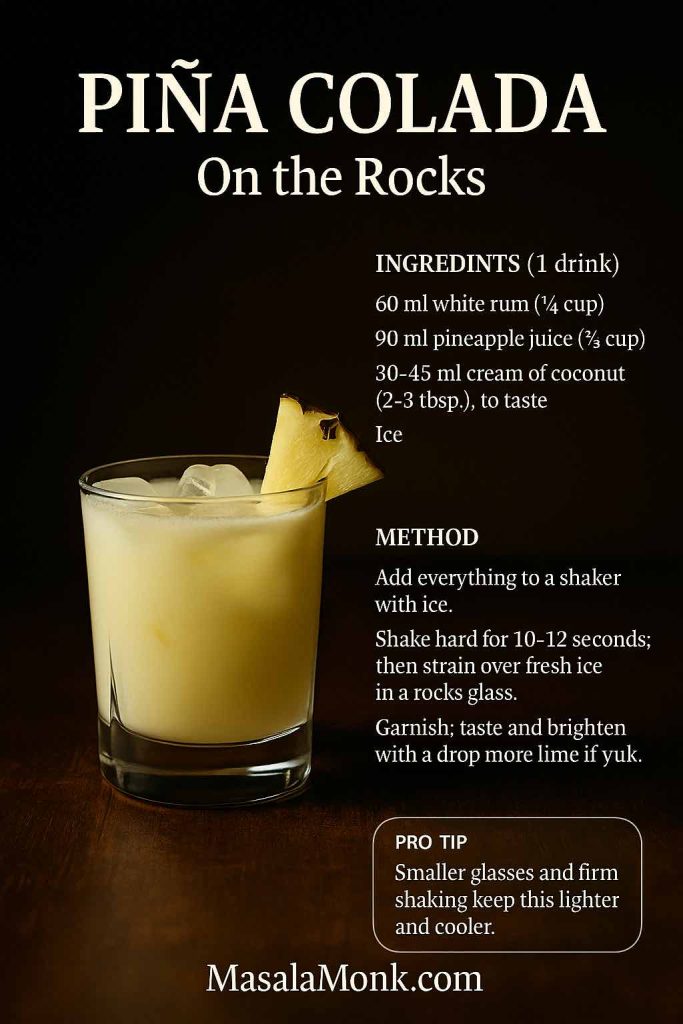
Ingredients (1 drink)
- 60 ml white rum (¼ cup)
- 90 ml pineapple juice (⅜ cup)
- 30–45 ml cream of coconut (2–3 tbsp), to taste
- 10 ml fresh lime juice (2 tsp, optional)
- Ice
- Pineapple wedge or citrus peel, to garnish
Method
- Add everything to a shaker with ice.
- Shake hard for 10–12 seconds; then strain over fresh ice in a rocks glass.
- Garnish; taste and brighten with a drop more lime if you like.
Why you’ll love it. Shaking gently aerates and adds just enough dilution to feel refreshing, not heavy. Smaller glasses (180–240 ml / 6–8 oz) keep the drink cold and focused. Moreover, when you’re making rounds, you can pre-mix pineapple juice + cream of coconut in a bottle; then just add rum and shake to order.
Virgin Piña Colada (and Virgin Piña Colada on the Rocks)
Virgin piña colada meaning: a non-alcoholic piña colada that keeps pineapple and coconut while skipping rum. For a lighter texture, shake on the rocks and finish with lime.
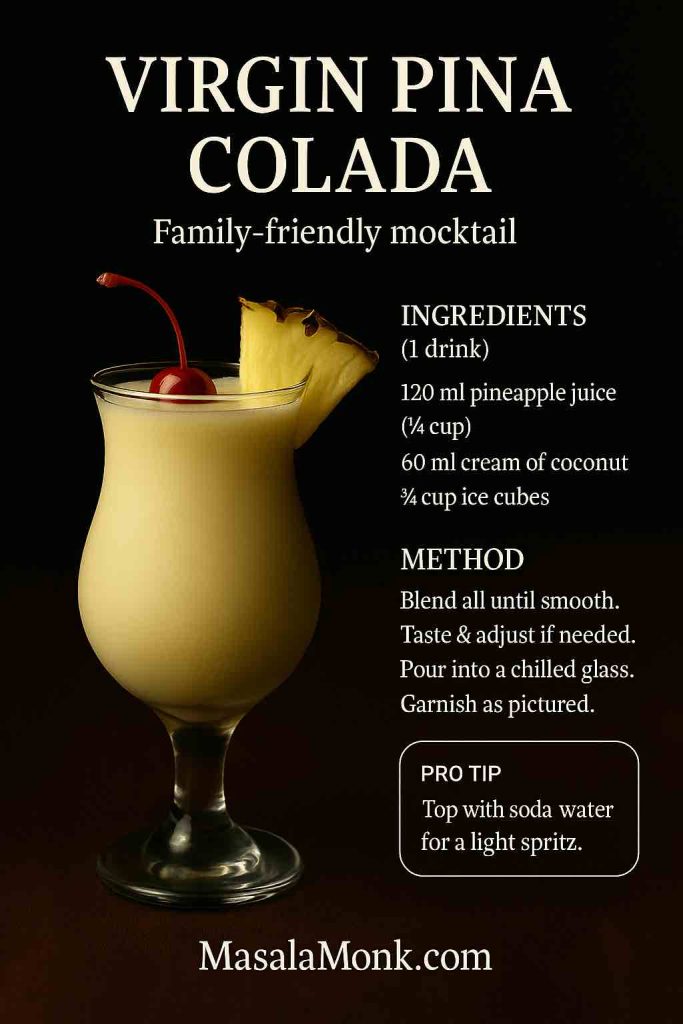
Ingredients (1 drink)
- 120 ml pineapple juice (½ cup)
- 45–60 ml cream of coconut (3–4 tbsp), to taste
- ½–1 cup ice (for frozen) or a shaker of ice (for rocks)
- Optional: 10–15 ml fresh lime (2–3 tsp) or 30–60 ml coconut water (2–4 tbsp)
Method
- Frozen: add juice and cream of coconut to a blender; add ice; blend until smooth. Adjust with a splash of juice or coconut water if needed.
- On the rocks: shake juice and cream of coconut with ice; strain over fresh ice. Add lime to taste.
Keep exploring (internal). For lighter, long drinks that echo these flavors, see Coconut Water Cocktails. If you enjoy mint and tang, try Pineapple Mojito Mocktails. For low-sugar days, browse Keto Mocktails.
How to build pina colada variations without a recipe
Because once you nail the base, it’s easy to improvise. First, keep the triangle of pineapple–coconut–spirit intact. Next, add an accent (fruit, spice, citrus, or liqueur). Then, adjust sweetness and texture in small steps. Finally, decide on frozen or rocks, and garnish with intention. With that in mind, here are ten reliable pina colada variations you can pour anytime.
Top 10 Pina Colada Variations
1) Strawberry Piña Colada (Lava-Flow: Fruity Pina Colada Variation)
When you want playful drama, strawberry is the simplest path. First, blend a thick strawberry base; next, blend your colada until silky; then, slowly pour it over the red layer so the “lava” rises in ribbons. As a result, you get classic coconut-pineapple comfort lifted by bright berry zip. Finally, keep both layers fairly thick so they ripple instead of mixing.
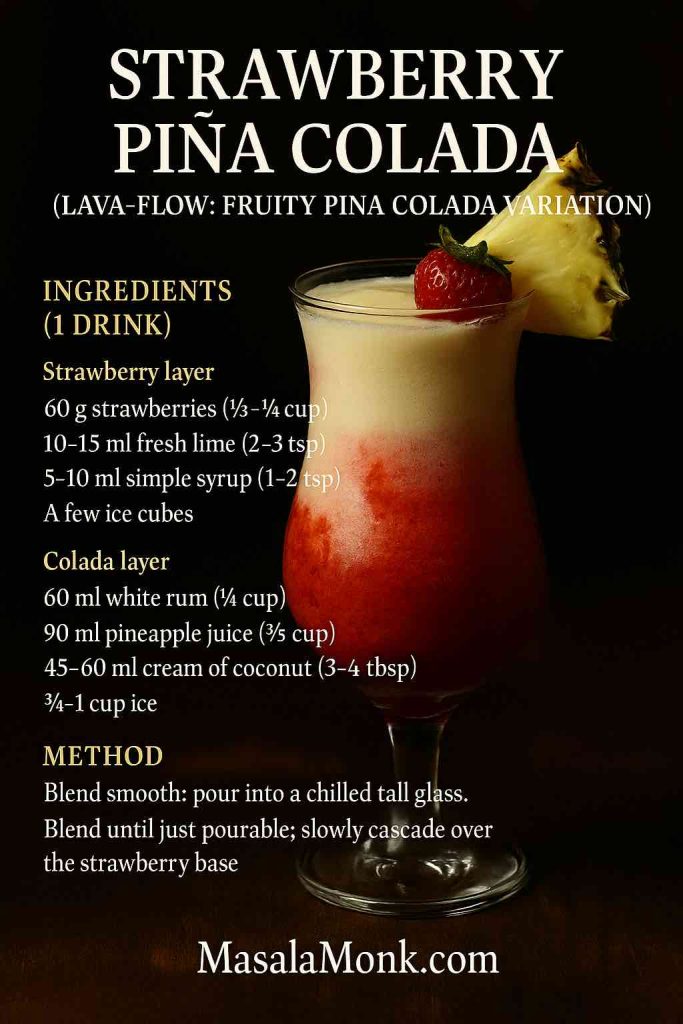
Strawberry layer (1 drink)
- 60 g strawberries (⅓–½ cup)
- 10–15 ml fresh lime (2–3 tsp)
- 5–10 ml simple syrup (1–2 tsp)
- A few ice cubes
Blend smooth; pour into a chilled tall glass.
Colada layer
- 60 ml white rum (¼ cup)
- 90 ml pineapple juice (⅜ cup)
- 45–60 ml cream of coconut (3–4 tbsp)
- ¾–1 cup ice
Blend until just pourable; slowly cascade over the strawberry base.
Pro tip. If berries are peak-sweet, reduce or skip syrup; conversely, if they’re tart, add an extra teaspoon.
2) Mango Colada (Tropical Pina Colada Variation)
Mango slides in silkily and, meanwhile, softens acidity. Next, use ripe fruit or a quality purée; if the texture feels dense, loosen with a splash of pineapple juice. Finally, a tiny pinch of salt heightens the mango’s aroma without reading “salty,” and a teaspoon of lime adds sparkle.
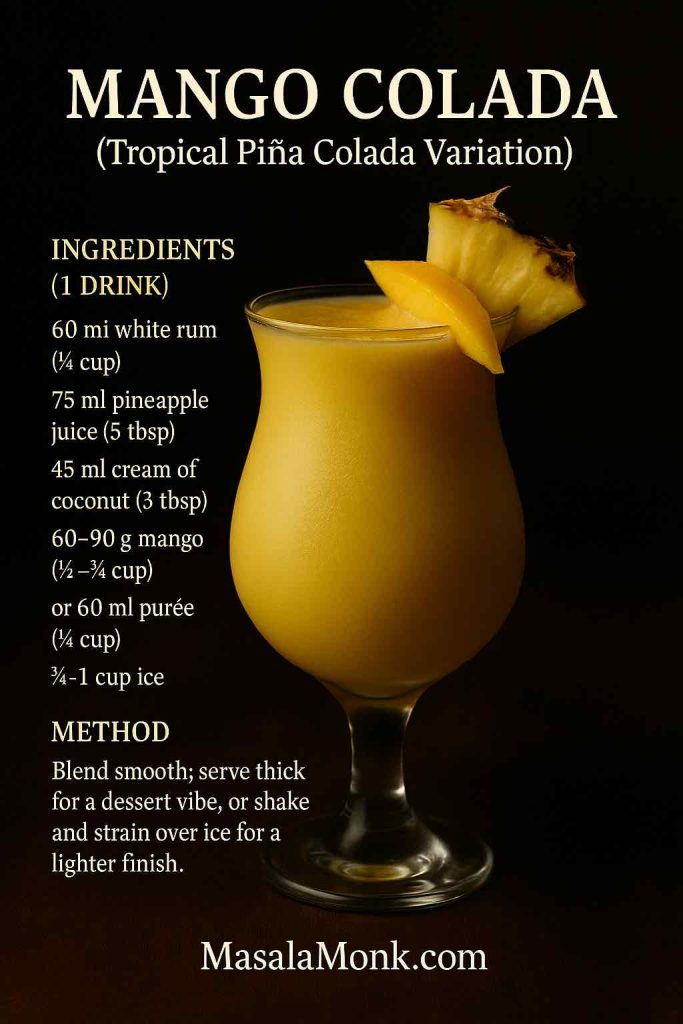
For 1 drink
- 60 ml white rum (¼ cup)
- 75 ml pineapple juice (5 tbsp)
- 45 ml cream of coconut (3 tbsp)
- 60–90 g mango (½–¾ cup) or 60 ml purée (¼ cup)
- ¾–1 cup ice
Blend smooth; serve thick for a dessert vibe, or shake and strain over ice for a lighter finish.
Love mango + vodka? Try these riffs: Mango Vodka Cocktail Drinks (Base + 7 Variations).
3) Blue Curaçao Colada (Blue Pina Colada Variation)
Sometimes you want familiar comfort and a little showmanship. Blue curaçao adds gentle citrus notes and that ocean-blue hue. Importantly, this isn’t a Blue Hawaii (a sharper, vodka-leaning sour); instead, it lands closer to a Blue Hawaiian, where coconut and pineapple still lead — compare Blue Hawaiian vs. Blue Hawaii.
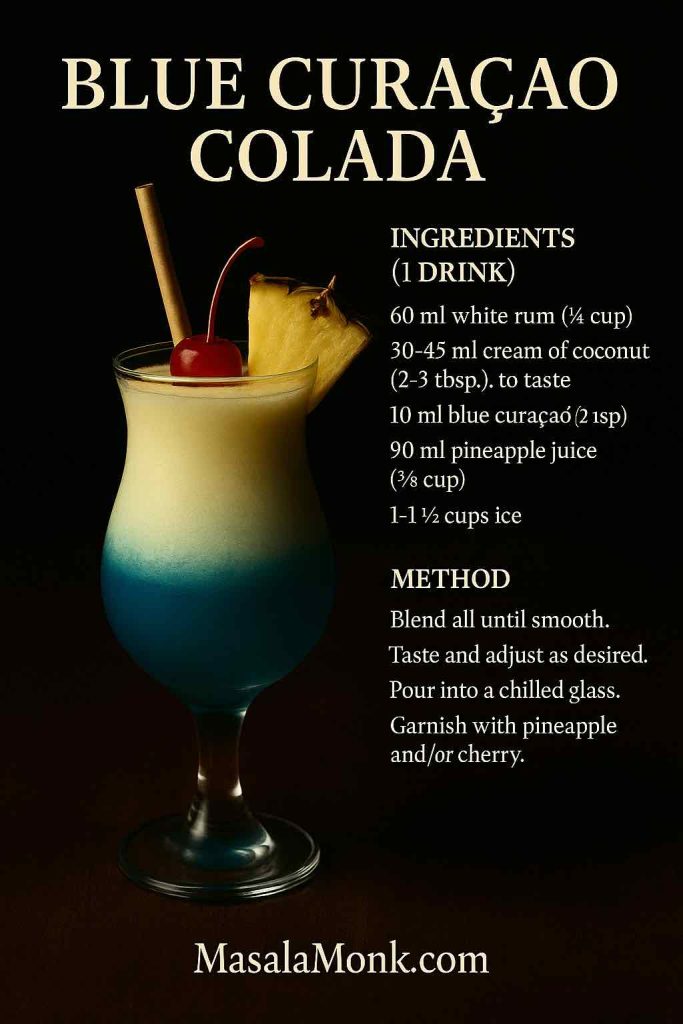
For 1 drink
- 45 ml white rum (3 tbsp)
- 15 ml blue curaçao (1 tbsp)
- 90 ml pineapple juice (⅜ cup)
- 45–60 ml cream of coconut (3–4 tbsp)
- ¾–1 cup ice
Blend or shake; add a few drops of lime only if sweetness lingers.
Color tip. Add ice gradually. Over-dilution can dull the blue.
4) Coconut-Rum Colada (Coconut-Forward Pina Colada Variation)
If you’re craving even more coconut, this is your lane. First, switch to coconut rum; then, because it’s sweeter than white rum, start at the lower end of the cream-of-coconut range. Afterward, taste and—if needed—counter with a few drops of lime so the finish stays tidy. Consequently, the drink reads lush and aromatic rather than sugary.
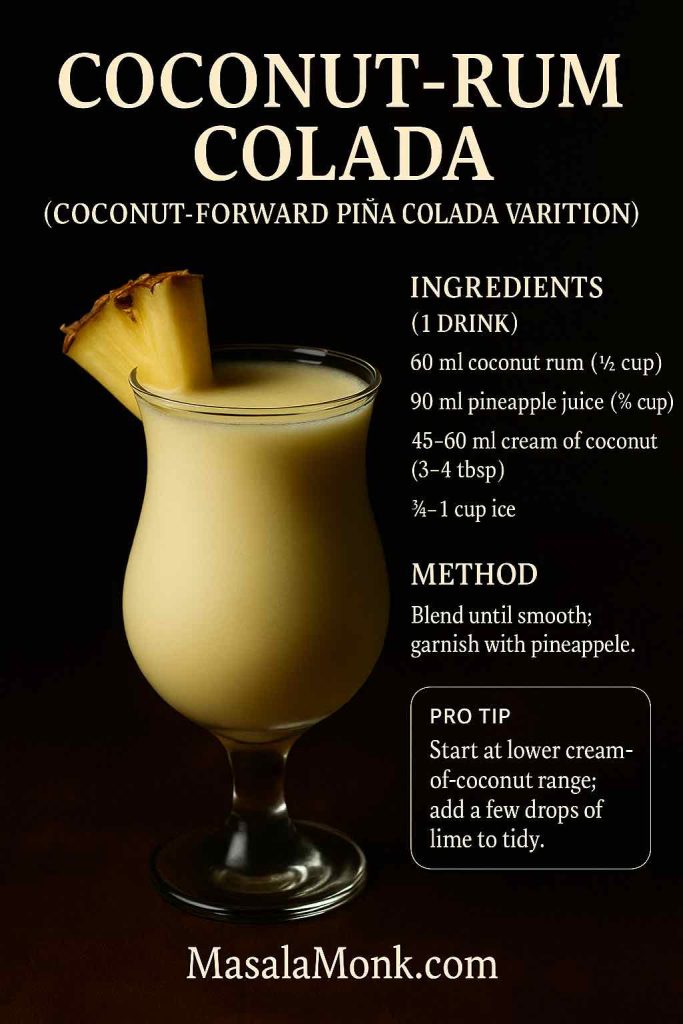
For 1 drink
- 60 ml coconut rum (¼ cup)
- 90 ml pineapple juice (⅜ cup)
- 45–60 ml cream of coconut (3–4 tbsp)
- ¾–1 cup ice
Blend until smooth; garnish with pineapple.
5) Spiced-Rum Colada (Cozy Pina Colada Variation)
When you want warmth and depth, spiced rum brings vanilla and baking-spice notes that cozy up to pineapple and coconut. Next, keep the cream of coconut moderate so the spices shine; then, grate a whisper of nutmeg over the top for aroma. Overall, you get a beachy drink with sweater-weather soul.
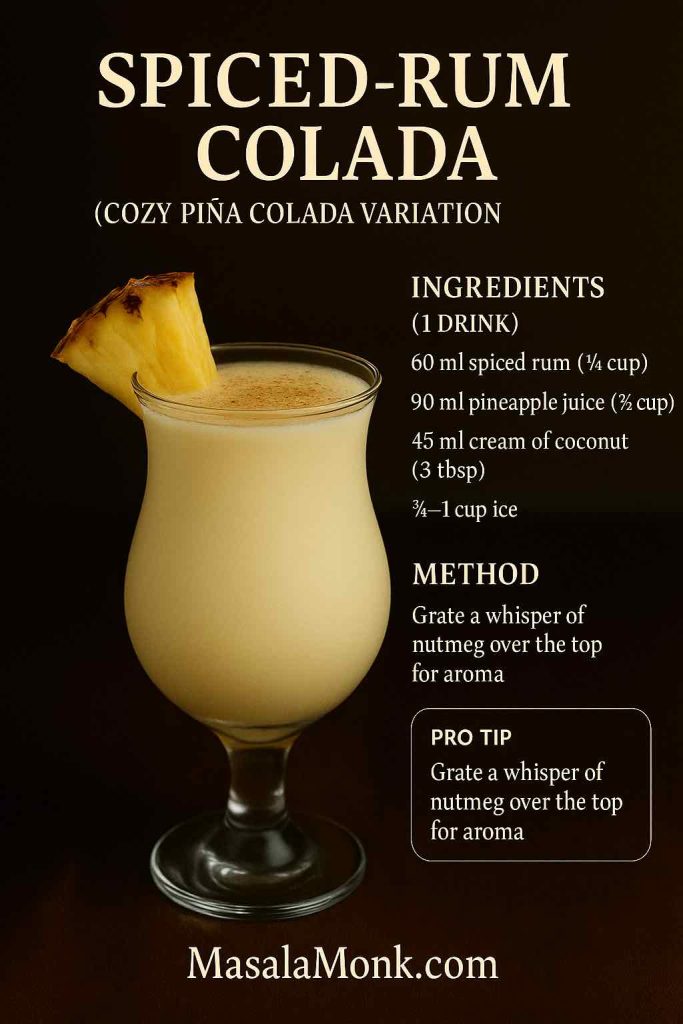
For 1 drink
- 60 ml spiced rum (¼ cup)
- 90 ml pineapple juice (⅜ cup)
- 45 ml cream of coconut (3 tbsp)
- ¾–1 cup ice
Blend, taste, and add 1 tsp lime if you want extra lift; serve frozen or shake and strain over ice.
6) Vodka Colada (Chi-Chi: Clean Pina Colada Variation)
Prefer a cleaner finish? In that case, swap rum for vodka. Because vodka is neutral, balance depends on your pineapple and coconut; therefore, taste before you pour. Meanwhile, serving tall over fresh ice emphasizes that breezy, easy-drinking feel, and a small pinch of salt can quietly boost pineapple.
For 1 drink
- 60 ml vodka (¼ cup)
- 90 ml pineapple juice (⅜ cup)
- 45–60 ml cream of coconut (3–4 tbsp)
- ¾–1 cup ice
Blend or shake; adjust with a few drops of lime if it tastes flat.
7) Tequila Colada (Crisp Pina Colada Variation)
When you’re in the mood for tropical with a little edge, tequila adds bright minerality that pairs beautifully with pineapple and coconut. Generally, blanco keeps it crisp; meanwhile, a tiny pinch of salt makes the fruit sing. Finally, a lime wheel garnish sets the tone.
For 1 drink
- 60 ml blanco tequila (¼ cup)
- 90 ml pineapple juice (⅜ cup)
- 45–60 ml cream of coconut (3–4 tbsp)
- Small pinch of salt (optional)
- ¾–1 cup ice
Blend until silky; garnish and serve.
Variation. For a Margarita-leaning twist, add 10–15 ml triple sec and shake on the rocks.
8) Skinny Colada (Light Pina Colada Variation)
Sometimes you want the flavor without the heft. So, swap in coconut milk and use just enough syrup to keep things balanced. Additionally, a squeeze of lime adds lift without extra calories; furthermore, shaking and serving on the rocks keeps it especially light and bright. Because coconut milk is thinner than cream of coconut, expect a silkier, less dessert-like body.
Nutrition-curious? See Coconut Milk Nutrition Facts & Glycemic Index.
For 1 drink
- 60 ml white rum (¼ cup)
- 90 ml pineapple juice (⅜ cup)
- 45 ml coconut milk (3 tbsp)
- 5–15 ml simple syrup (1–3 tsp), to taste
- ¾–1 cup ice
Blend or shake; sweeten a teaspoon at a time until it lands just right.
9) Keto-Leaning Colada (Lower-Sugar Pina Colada Variation)
If you’re watching sugar, this is the smart pivot. First, keep pineapple modest. Next, use unsweetened coconut cream. Then, sweeten with your preferred keto option. Finally, swap some ice for frozen pineapple so body improves without a big sugar bump. For more low-carb ideas, browse Keto Mocktails.
For 1 drink
- 60 ml white rum (¼ cup)
- 60–75 ml pineapple juice (¼–⅓ cup) or a mix of juice + water
- 45 ml unsweetened coconut cream (3 tbsp)
- Keto sweetener, to taste
- ¾–1 cup ice
Blend smooth; finish with a squeeze of lime to sharpen the edges.
Optional. A drop or two of coconut extract boosts aroma without adding carbs.
10) Frozen Pineapple Colada (Maximum-Fruit Pina Colada Variation)
For maximum fruit and minimal dilution, frozen pineapple replaces much of the ice. Consequently, the texture stays lush, the flavor gets louder, and the chill lasts to the final sip. If your blender struggles, pulse a few times before running continuously; then, loosen with a splash of juice only if necessary.
For 1 drink
- 60 ml white rum (¼ cup)
- 60 ml pineapple juice (¼ cup)
- 45–60 ml cream of coconut (3–4 tbsp)
- 1 heaping cup frozen pineapple chunks
Blend thick and silky; pour into a tall, well-chilled glass.
Types of Coladas (Piña Colada Type Drinks)
Although the piña colada is the icon, there’s a whole colada family. For example, try:
- Piña Verde: herbal green notes over the pineapple-coconut base.
- Banana Colada: thicker, softer mouthfeel from ripe banana.
- Champagne Colada: topped with sparkling wine for a celebratory finish.
- Mango Colada: silkier fruit body and perfume.
- Blue Colada: blue curaçao for citrus notes and a vivid hue.
Consequently, you can match mood—lush and frozen for weekends, or bright and shaken on busy nights. Moreover, these quick pivots turn the classic into a set of pina colada variations that never feel repetitive.
Drinks Similar to a Piña Colada
If you enjoy the piña colada, you’ll likely love drinks similar to a piña colada. First, try the Miami Vice—half strawberry daiquiri, half piña colada, fully festive; the recipe on Liquor.com is reliable. Next, mix a Painkiller—rum, pineapple, orange, and cream of coconut with a nutmeg finish—using the official spec on Pusser’s Rum.
Finally, for fast color gradients and sweet-tart layers, explore Mocktails with Grenadine for non-alcoholic ideas you can adapt.
Ingredient buying guide (quick but useful)
Pineapple juice. Fresh-pressed tastes bright and aromatic; however, high-quality canned juice blends smoothly and is wonderfully consistent. Keep it chilled and use it within a few days for the best foam and flavor.
Cream of coconut vs. coconut milk. Coconut milk is unsweetened and lighter; cream of coconut is sweetened and thicker, designed for cocktails. If you substitute, rebalance sweetness and expect a different mouthfeel. For clarity, this guide to cream of coconut vs. coconut milk explains the swap smartly.
Rum. A clean white rum is the classic choice. If you prefer deeper flavor, aged or spiced rum works beautifully—just reduce cream of coconut slightly or add a little lime so sweetness doesn’t dominate.
Citrus. Fresh lime is your editor. Even a teaspoon or two can transform a heavy finish into a bright one.
Salt. A literal pinch can make fruit taste “riper.” Use sparingly and always taste.
Technique tips that instantly upgrade your glass
- Chill everything. Cold inputs blend smoother and hold foam longer.
- Liquids first, ice last. In blenders, layering liquids before ice helps avoid cavitation.
- Pulse, then finish. Short pulses break big pieces; a brief continuous blend polishes texture.
- Shake like you mean it. For rocks versions, firm shaking (10–12 seconds) delivers perfect chill and dilution.
- Mind your glassware. Tall glasses flatter frozen drinks; compact rocks glasses keep shaken versions bright and cold.
- Garnish with intent. Pineapple fronds, a fresh wedge, or even a citrus peel add aroma where your nose meets the glass.
Make-ahead, batching, and easy swaps
No cream of coconut? Substitute coconut milk plus simple syrup, adjusting in tiny steps. The texture will be lighter but still silky.
No blender? Shake the on-the-rocks version hard with cracked ice. If you want extra body, add a small spoon of coconut milk before shaking.
Dairy-free needs? These recipes are naturally dairy-free; if you add ice cream for a dessert riff, reduce sweetener and add a pinch of salt.
Batching for parties. Blend a quadruple-size base without ice; chill deeply. Just before serving, either blend portions with ice for frozen service or shake portions with ice for rocks service. Because melted ice thins sweetness, taste after chilling and bump cream of coconut or lime by a teaspoon if needed.
Make-ahead shortcut. Pre-blend a “colada mix” by stirring equal parts cream of coconut and pineapple juice; keep it cold. During service, add spirit and ice, then blend or shake. This saves time and keeps ratios consistent across a long evening.
Prefer lighter long pours? Skim ideas in Tropic Like It’s Hot: Coconut Water Cocktails for Summer.
Pina colada flavored drinks: quick pivots you can do in 60 seconds
Sometimes you don’t want a whole new recipe—just a shift in mood. Therefore, try these tiny changes: add a teaspoon of lime for snap; swap in coconut milk for a lighter feel; drop in 15 ml blue curaçao for color; stir in 30 ml mango purée for silk; or finish with grated nutmeg for warmth. In short, these micro-moves turn the base into pina colada variations that stay familiar yet fresh.
A friendly close
You now have a complete island toolkit: a dependable classic, a quick piña colada on the rocks, a zero-proof path, and ten flexible pina colada variations that keep things interesting. Start with the frozen original; then try the lighter rocks version on a weeknight. Once you know which texture feels most like you, branch into strawberry, mango, or blue curaçao and see what sticks.
When you land on a new favorite—or discover a clever garnish—share it so others can try it too. Tropical, relaxed, and simple—that’s the piña colada at its best.
FAQs
1) What does “piña colada” mean?
Simply put, it means “strained pineapple.” In other words, the name points to fresh or pressed pineapple juice at the drink’s heart. From there, coconut and rum complete the classic trio; however, you can skip the rum for a virgin version and still keep the sunny flavor.
2) Is the piña colada Puerto Rican?
Yes. Most stories trace the cocktail to San Juan, Puerto Rico. Consequently, you’ll often see it called the island’s national drink. While the inventor is debated, the flavor profile—pineapple, coconut, and rum—clearly began there and then traveled the world.
3) Frozen vs. on the rocks: which piña colada should I choose?
It depends on mood. Frozen is lush, creamy, and a little dessert-like; meanwhile, piña colada on the rocks feels lighter and brighter because hard shaking adds chill and subtle dilution. So, choose frozen for lazy afternoons and rocks for quick weeknights.
4) How do I make a virgin piña colada (including on the rocks)?
It’s easy. First, combine pineapple juice with cream of coconut; then, either blend with ice for a frosty treat or shake hard and serve over fresh ice for a lighter sip. Finally, a squeeze of lime balances sweetness, and a splash of coconut water lengthens the drink without extra sugar.
5) What are the most popular pina colada variations?
Start with simple winners: Strawberry (lava-flow), Mango, Blue Curaçao (Blue Colada), Coconut-Rum, Spiced-Rum, Vodka (Chi-Chi), Tequila, Skinny, Keto-leaning, and Frozen Pineapple. Because each keeps the pineapple-coconut core, you can swap spirits or fruit and still taste “piña colada.”
6) Which rum is best—white, coconut, or spiced?
As a rule, white rum is clean and versatile. Coconut rum adds extra coconut sweetness; therefore, reduce cream of coconut slightly or add a few drops of lime. Spiced rum brings vanilla and baking-spice notes; consequently, the drink feels cozier, especially with a pinch of nutmeg.
7) Can I make a piña colada with vodka or tequila?
Absolutely. Vodka creates a silky, neutral canvas where pineapple shines; meanwhile, tequila (especially blanco) adds crisp minerality that many love. Accordingly, both are recognized pina colada variations—great for guests who don’t usually choose rum.
8) Cream of coconut vs. coconut milk: what’s the difference?
Cream of coconut is sweetened and thick, which yields that classic, velvety texture. Coconut milk is unsweetened and lighter. Therefore, if you substitute coconut milk, add a little simple syrup and expect a silkier, less dessert-like body—perfect for skinny riffs.
9) How can I make a skinny or keto piña colada?
For skinny, use coconut milk and sweeten lightly, then brighten with lime. For keto-leaning, use unsweetened coconut cream, keep pineapple juice modest (or cut with water), and sweeten with your preferred keto option. Finally, blending a few frozen pineapple chunks boosts body without a big sugar hit.
10) Can I make a piña colada without a blender?
Yes—shake it. First, combine pineapple juice, cream of coconut, and spirit in a shaker with plenty of ice; next, shake hard for 10–12 seconds; then, strain over fresh ice. As a result, you’ll get a piña colada on the rocks that’s fast, cold, and refreshingly light.
11) What drinks are similar to a piña colada?
If you like the style, try a Miami Vice (half strawberry daiquiri, half colada) or a Painkiller (rum, pineapple, orange, cream of coconut, nutmeg). Likewise, explore the broader family of coladas and easy pina colada variations like Blue Colada or Banana Colada when you want something familiar yet new.
12) What are the main “types of coladas” (piña colada type drinks)?
Think of “colada” as a creamy coconut family. For example, there’s Piña Verde (herbal), Banana Colada (thicker and softer), Champagne Colada (bubbly and celebratory), Mango Colada (silky and perfumed), and Blue Colada (citrusy and vivid). Accordingly, you can match the drink to the moment.
13) How do I fix a piña colada that’s too sweet, too thin, or too thick?
If it’s too sweet, add a few drops of lime or a splash of pineapple juice for acidity, if it’s too thin, blend in frozen pineapple or a bit more ice and if it’s too thick, loosen with a small splash of juice. Meanwhile, a tiny pinch of salt can quietly make fruit taste “riper.”
14) What garnish works best—and does it change the flavor?
A pineapple wedge, fronds, or a lime wheel adds aroma right where you sip. Additionally, a gentle nutmeg grate complements spiced-rum coladas. Because your nose leads the experience, even simple garnishes make each of your pina colada variations feel more polished.
15) Can I batch piña coladas for a party?
Definitely. First, blend a big base of pineapple juice and cream of coconut (without ice) and chill it well. Next, add rum to individual portions and either blend with ice for frozen drinks or shake on the rocks to order. Finally, taste after chilling; you may need a touch more lime or cream of coconut to keep balance.
16) What’s the easiest way to try multiple pina colada variations in one night?
Start with a classic base and pour it into two small blenders or shakers. Then, split accents: add strawberry to one and mango to the other; or try blue curaçao in one and tequila in the next. Consequently, you’ll compare flavors side by side without remaking the whole recipe.
17) Are “pina colada flavored drinks” different from full coladas?
Sometimes, yes. Think of them as quick pivots: add mango purée, a dash of blue curaçao, a squeeze of lime, or even coconut milk instead of cream of coconut. In short, these small tweaks turn the base into pina colada flavored drinks that stay familiar yet feel brand new.
18) What glass should I use—tall or rocks?
Use a tall, chilled glass for frozen coladas to keep the slush cold and lively. Conversely, choose a compact rocks glass (about 180–240 ml) for piña colada on the rocks so the flavors stay focused while the ice chills, not waters down, the drink.
19) How do I keep my piña colada cold outdoors without watering it down?
First, chill your glassware. Next, use pre-chilled juice and spirit. Then, for frozen versions, swap part of the ice for frozen pineapple so flavor stays loud as the drink warms. Finally, enjoy promptly—because even the best slush softens in the sun.
20) What single tip improves every pina colada variation?
Taste, then tweak in tiny steps. Add sweetness in teaspoons, lime in ½-teaspoon splashes, and ice in small handfuls. As a result, mouthfeel, balance, and aroma land exactly where you want—no matter which pina colada variations you’re trying tonight.
